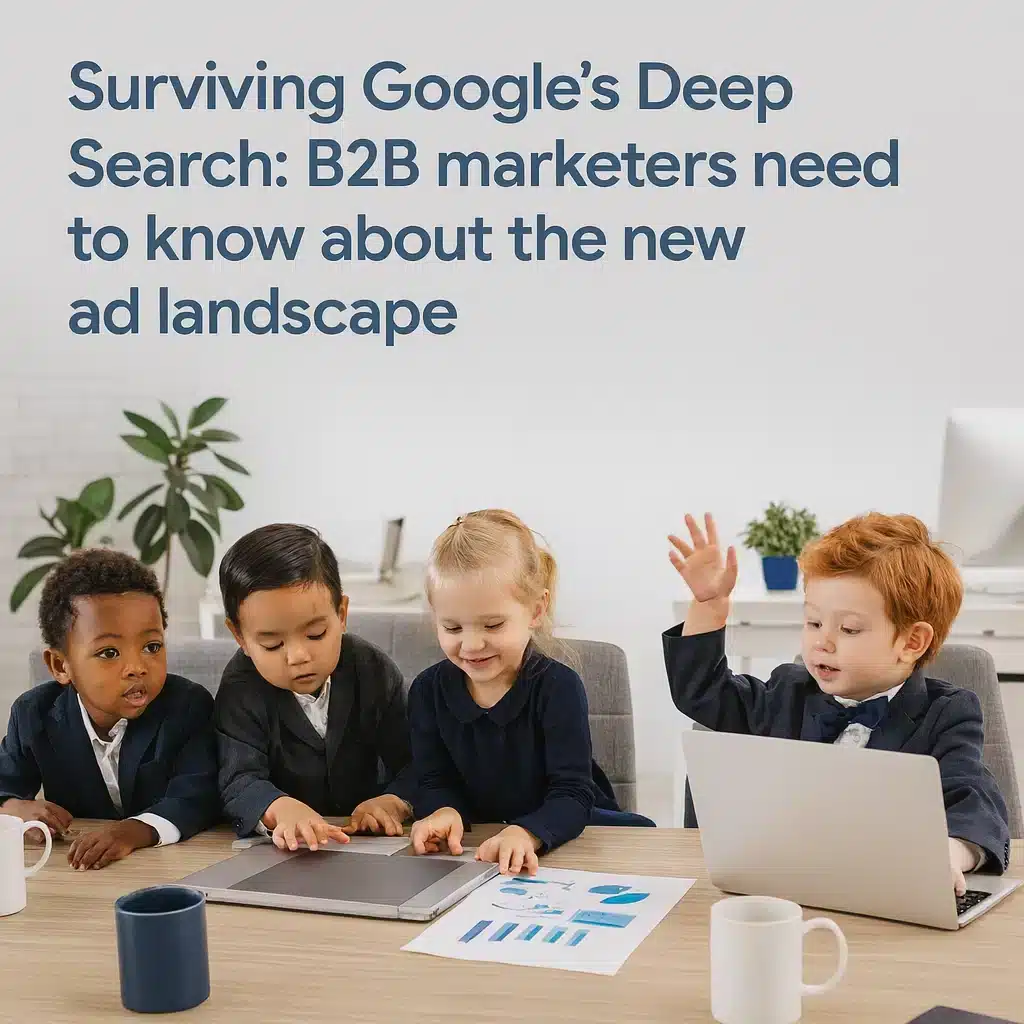Welcome to the Era of Deep Search
Imagine you’re dropped into a boardroom packed with toddlers who are all dressed like seasoned CEOs, parsing out complex business problems (and maybe trying to order juice with their next round of funding). That’s a bit what Google’s Deep Search feels like in today’s B2B landscape: sophisticated technology doing grown-up work, but the rules have changed and the game is more playful (and sometimes, more unpredictable) than ever.
Deep Search, introduced at Google I/O 2025, isn’t your standard “search update.” Instead, it’s a full re-think of how business questions get answered online. Rather than spitting out a simple list of links, Deep Search breaks your questions into snackable chunks, cross-checks the web (and your digital footprint), then personalizes the answer based on what it already knows about you and your interests as a user.

What Exactly Is Deep Search?
Deep Search operates kind of like a brainy toddler with access to an endless filing cabinet. Instead of giving one flat answer, it:
- Breaks long, complex queries into smaller, bite-sized questions.
- Searches for each sub-question in parallel, not just sequentially.
- Delivers a layered, synthesized answer pulling in insights from multiple sources.
- Reveals different results depending on user context, search history, Gmail, YouTube, and Maps activity.
For B2B marketers, this means every search is deeply personal, context-driven, and constantly evolving. If you’re building a pipeline or nurturing relationships, you can’t just rely on being #1 for a keyword anymore. You need to be present, reference-worthy, and relevant across the spectrum of a buyer’s digital journey.
B2B Discovery Looks Different Now
A buyer searching “CRM for fast-growing nonprofits” no longer sees a single, static set of blue links. Instead, Deep Search slices the query into pieces:
- What CRM features matter for nonprofits?
- How do CRM needs change as nonprofits scale?
- What integrations do nonprofit teams prioritize?
Each slice pulls from authoritative, cited content, relevant videos, business profiles, customer reviews, and even prior user activity. As a marketer, you’re now competing for a spot in every contextually rich response, not just trying to land on page one.
Hyper-Personalization: One Size Fits None
This is where things get interesting: the same search made by two different B2B decision-makers can generate totally different experiences, all shaped by what Google knows about their unique work patterns, search history, email activity, and even YouTube habits.
- If you’re a marketing director at a SaaS company and you’ve been diving into automation tools, Deep Search might show you CRM solutions with advanced workflow features, citing content from blogs you’ve recently visited or LinkedIn pages you’ve bookmarked.
- Meanwhile, your peer in finance will see CRM results focused on compliance and audit thanks to their recent spreadsheet digging in Google Drive and a whole different Gmail trail.
Chasing top keywords and ad bids barely scratches the surface for today’s marketers. Success depends on building trust and earning visibility across your full set of digital assets, including your website, case studies, explainer videos, and well-maintained Google Business or YouTube profiles.

Why This Shifts the B2B Advertising Game
Every marketer is asking, “How do I keep my business in front of the right decision-makers if Google is tailoring the landscape for each click?”
Let’s break down what’s changed:
1. Content-Centric Campaigns Trump Keyword-Only Buys
Topic clusters (that is, a thoughtfully organized network of connected content on your site) are now far more important than any isolated landing page. Your campaigns should guide folks to robust resource centers, FAQs, practical how-to articles, and genuine customer stories. This kind of “ecosystem” makes it much easier for Deep Search’s AI to recognize your expertise and pull your brand into search responses repeatedly, not just once.
2. Multi-Channel Presence is Essential
Don’t just live on your website. Authentic, well-maintained profiles on YouTube, Google Business, and even third-party industry forums all serve as signals. Buyers are nudged to “meet your brand” multiple ways before reaching out.
3. Dynamic Paid Strategies
Because Deep Search can’t be gamed in the old way, paid ads require more nuance. Retargeting must feel genuinely helpful (not stalkerish), banner and display ads need to reinforce your value-based messaging, and your creative should be flexible enough to fit into different buyer journeys instead of just trying to drive clicks.
Measurement & Attribution: Old Metrics Are Out
Gone are the days of obsessing over a single keyword ranking or basic organic traffic numbers.
- AI Overview placements are not transparent in Search Console (yet).
- Branded search volume, long-tail keyword tracking, and impression share have become more telltale.
- Lead quality—especially whether new prospects mention having seen your content in multiple places—is now a crucial measure.
- Engagement with cited sources (e.g., a prospect says, “I saw this use case referenced by Google’s AI overview…”) is gold.
How SMBs Can Actually Survive (and Thrive)
So, how does your small or mid-sized business navigate this quirky playground of digital bosses in diapers? Here’s what’s working now:
Build Interconnected Content Ecosystems
Develop interconnected resource pages, blog articles, and case studies. Link them thoughtfully and make sure you’re nurturing buyers through every stage, for example, by answering questions all the way from “what is CRM for nonprofits” to “migration tips for fast-growing organizations.”

Get Multi-Channel, But Stay Human
- Write blog posts and FAQs in your brand’s real voice, not just for algorithms.
- Update and maintain your business’s YouTube and Google Business profiles. Even short explainer videos or quick insights contribute authority and visibility.
- Share educational content on LinkedIn and encourage your actual team to engage (not just the brand account).
Smart, Value-Driven Ad Campaigns
- Run display ads around your resource hubs, not just product pages.
- Use hyper-targeted audience lists built on real prospect profiles, focusing on repeated value rather than the hard pitch.
- Leverage remarketing to nurture, not nag: Share free industry guides, invite contacts to webinars, or highlight success stories.
Embrace Data (But Expect Fuzziness)
New tools for monitoring branded search, tracking long-tail performance, and analyzing post-click engagement will help you spot trends, even if they’re less precise than in the old SEO world.
Tips for Teams: Relationship Over Reach
- Train your front-line staff. Every new inquiry could be coming from a prospect who’s already engaged with your content across Google’s many surfaces. Listen, ask what stood out to them, and adapt accordingly.
- Document the journey. Use a CRM that allows you to note when a lead mentions a specific blog post, video, or AI-generated source.
- Collaborate cross-team. Your marketing narrative, sales team insights, and customer success stories should feed into a unified strategy, since Deep Search cross-references all of it.

Deep Search Survival Checklist
- Audit your current content. Are you addressing the full buyer journey by providing real answers, not just pitches?
- Develop topic clusters and thoughtfully linked resource sections.
- Diversify your brand’s online presence. Pay special attention to platforms like YouTube.
- Create ads that support relationship-building, education, and trust instead of focusing on sales.
- Measure lead quality using indicators of multi-touch engagement, not only the final interaction.
- Foster real connections. Personalize every follow-up with relevant references to content or knowledge your prospect already engaged with.
Surviving Google’s Deep Search isn’t about gaming the system. It’s about showing up with real knowledge, building trust, and meeting your audience across all their digital touchpoints, even if they’re dressed in a miniature suit, sipping from a sippy cup, and ready to close the deal.

